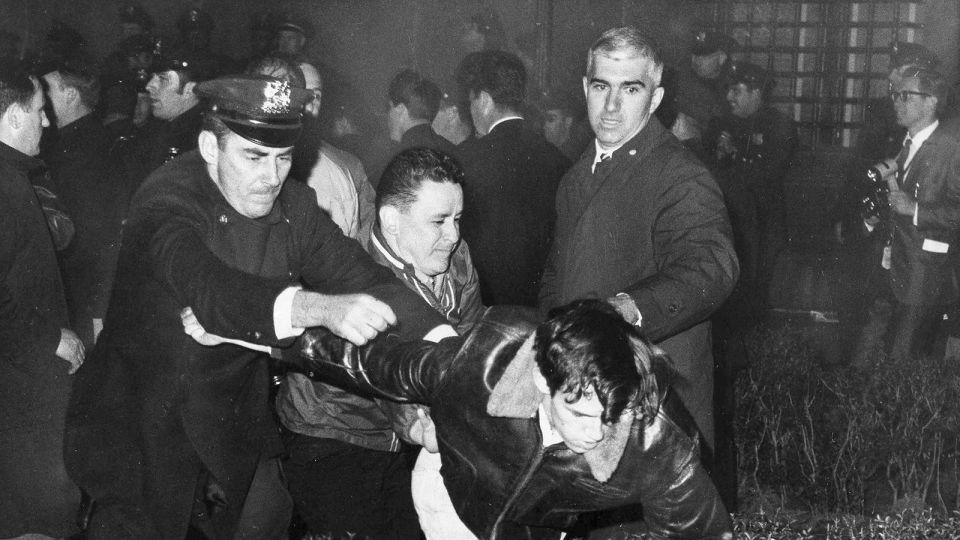In 1968, protests forced Columbia University to change graduation. Here’s what happened next.
Columbia University’s graduating class of 1968 was no stranger to protests. The college years of its student body were marked by the anti-Vietnam War movement and the fight for civil rights.
In the spring of that year, a series of events – including the assassination of Dr. Martin Luther King Jr. – inflamed long-simmering tensions between students and school administrators and in April, the campus erupted as students occupied buildings during a “strike” that lasted more than a week.
In the fallout of the strikes, then-university president Grayson Kirk moved the 1968 commencement ceremony from its traditional location on campus to the Cathedral Church of St. John the Divine, a few blocks away.
It is spring once more, 56 years later, and Columbia finds itself at a similar crossroads now that the administration canceled the class of 2024’s university-wide graduation ceremony in response to student protests over Israel’s against Hamas in Gaza. Where Columbia goes from here could depend on whether it hears the echoes of past protests.

When movements collide
Columbia University’s library details the events that led to 1968’s controversial commencement in an online exhibit called “1968: Columbia in Crisis.”
In the months leading up to graduation, protests roiled the university’s campus as students from various groups led demonstrations against what they perceived to be the administration’s racist policies and pro-war stance.
In April 1967, a dispute at a US Marine Corps recruitment event sparked an “hour-long melee of fist fights and name-calling,” according to the Columbia Spectator. The brawl led Kirk to ban all demonstrations and protests within campus buildings.
Students who violated the ban faced “disciplinary action and possibly dismissal,” according to the Spectator, but it didn’t stem the growing tide of disillusionment and frustration among Columbia’s student body.

Throughout 1968, students and members of the surrounding Harlem community protested the university’s plans to build a gym in nearby Morningside Park, decrying the racism they saw in the separate and unequal access to the facilities, according to the university archive.
Students and faculty also continued to oppose the university’s involvement with the military, including Kirk’s seat on the board of the Institute for Defense Analyses, a coalition of universities and government agencies conducting military research that’s still in operation today.
Then on April 4, 1968, Dr. Martin Luther King Jr. was assassinated.
As the nation reeled from Dr. King’s murder, the university held a memorial in his honor. During the service, the chairman of Students for a Democratic Society, a progressive student group, accused administrators of upholding “a policy of racism” and committing a “moral outrage against Dr. King’s memory,” according to the Spectator.
He then led dozens of students in a walk out, the Spectator reported.

Campus implodes as students strike
In the weeks after Dr. King’s assassination, students from various on-campus groups united around the opposition to the Morningside gym.
On April 23, organizers held a “Sun Dial Rally” that featured a demonstration and march to the gymnasium site. Students then staged a sit-in at Hamilton Hall – the same university building protesters occupied this year – and made their demands known. They included ending construction of the gym and demanding President Kirk sever ties with the Institute for Defense Analyses.
Word of the demonstration spread like wildfire through Columbia’s student body and students began to occupy other buildings across campus.
The occupation would last for more than a week, as administrators tried in vain to negotiate with the student groups to find a resolution.

Then, in the early hours of April 30, 1968, the administration sent the New York City Police Department to remove students from the buildings on campus.
More than 700 students were arrested and nearly 150 were injured as police cleared the campus, according to the university’s archive.
The arrests only enflamed tensions between students and the Columbia administration. The strike continued through the remainder of the semester as students called for the resignation of President Kirk and the university’s provost.

Commencement becomes chaotic
Columbia’s class of 1968 graduated on June 4 and in a departure from tradition – and perhaps in acknowledgement of the tensions between students and his administration – Kirk did not deliver the commencement address.
Instead, Richard Hofstadter, a history professor, spoke at a ceremony a few blocks from campus.
As Hofstadter began to speak, about 300 members of the graduating class silently walked out. They marched to the university’s Low Plaza, where nearly 2,000 people participated in a counter-commencement, according to the university archive.
Those who remained to hear Hofstadter’s speech that day were presented with a question: What kind of university do we want to be?
“Here at Columbia, we have suffered a disaster whose precise dimensions it is impossible to state, because the story is not yet finished, and the measure of our loss still depends upon what we do,” Hofstadter said.

“How can Columbia go on after this terrible wound? I can only answer: How can it not go on? The question is not whether it will continue but in what form,” he said.
Although it took Columbia University years to recover and reestablish trust between the administration and the student body, several key changes emerged after the 1968 protests.
In March the following year, after working with Black student-leaders, Kirk agreed to suspend construction on the Morningside Gymnasium, according to the university’s archive.
Students and faculty also overwhelmingly approved the creation of a University Senate that spring. The senate, according to the university’s archives, was composed of faculty, students and administrators and is an outlet to address “all matters of University-wide concern.”
For more CNN news and newsletters create an account at CNN.com


